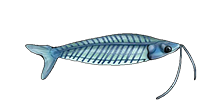| Scientific Name | Panaqolus sp. (L397) |
| Common Names | L397, Rødstribet Sugemalle (Denmark) Tangerine Tiger Pleco |
| Pronunciation | pan ack oh luss |
| Etymology | Panaqolus: Inelegantly derived from the indigenous term Panaque and in a form that infers a smaller size than that genus. |
| Size | 110mm or 4.3" SL. Find near, nearer or same sized spp. |
| Identification | L397 is noted for its bold orange and black bands on the body and fins. On the body and fins of juveniles, and on the fins of adults, the orange and black bands are separated by transparent or white bands. In adults, the orange bands on the body may remain orange-red, or mellow to a shade of brown, but the fins retain an orange-red hue. Another character of L397 is the facial markings: Early in life, the face develops densely packed thin orange and black longitudinal lines, which twist to give the face a slightly scrolled pattern. The abdomen can be white or patterned. |
| Sexing | Mature males can be easily identified by the presence of odontodes covering the caudal peduncle. Most similar-sized females will entirely lack these odontodes and will be wide-bodied when full of eggs. |
| Distribution | Lower Amazon, near Alenquer. Amazon, Lower Amazon (click on these areas to find other species found there) Login to view the map. |
| pH | 6.4 - 7.7 |
| Temperature | 24.0-30.0°C or 75.2-86°F (Show species within this range) |
| Other Parameters | L397 is relatively tolerant of water hardness. Breeding has been reported in water with conductivity/TDS values ranging from around 200 to 700 uS/cm (125-450 ppm TDS). |
| Feeding | As with other Panaqolus, vegetables (e.g., yams, courgette, Brussels sprouts) and wood should form the core diet for L397. Also, these fish will eagerly eat meaty foods such as shrimp, clams, and live black worms; a meat meal about 1-3 days per week can help condition the fish for spawning. User data. |
| Furniture | Cobblestones and wood pieces. Plants may be damaged so are not necessary. |
| Suggested Tankmates | Other Loricariids, corys, tetras, and community-compatible cichlids. |
| Breeding | Females lay between 25 and 40 eggs, around 6mm in diameter. Males care for the eggs and fry. After approximately 7 days the egg-sack is consumed. The fry aren't particularly sensitive, but should have access to soft wood to chew on; this combined with algae tablets and a little bit of high protein food will have them grow quickly and are sexually mature after around a year. They will spawn in ceramic caves, but seem to prefer caves made from bamboo, but they will chew this type of cave to bits. Spawning takes place at a temperature between 26 and 30C and a conductivity between 200 and 700 uS/cm (around 125-450ppm TDS). Circulation needs to be good but not strong. |
| Breeding Reports | There are 23 breeding reports, read them all here. |
| Reference | DATZ 10/2005. |
| Registered Keepers | There are 278 registered keepers, view all "my cats" data. |
| Wishlists | Love this species? Click the heart to add it to your wish list. There are 50 wishes to keep this species, see who wants what. |
| Spotters | Spotted this species somewhere? Click the binoculars! There are 182 records of this fish being seen, view them all. |
| Forum BBCode | |
| Search for P. sp. (L397) | |
| Look up P. sp. (L397) on AquaticRepublic.com | |
| LFS label creator ARN ref:1.4.762.1847 | |
| Last Update | 2022 Oct 29 07:58 (species record created: 2006 Apr 01 00:00) |





/siluriformes/loricariidae/panaqolus/sp%28l397%29/1.jpg)
/siluriformes/loricariidae/panaqolus/sp%28l397%29/2.jpg)
/siluriformes/loricariidae/panaqolus/sp%28l397%29/3.jpg)
/siluriformes/loricariidae/panaqolus/sp%28l397%29/4.jpg)
/siluriformes/loricariidae/panaqolus/sp%28l397%29/5.jpg)
/siluriformes/loricariidae/panaqolus/sp%28l397%29/6.jpg)
/siluriformes/loricariidae/panaqolus/sp%28l397%29/7.jpg)
/siluriformes/loricariidae/panaqolus/sp%28l397%29/8.jpg)
/siluriformes/loricariidae/panaqolus/sp%28l397%29/9.jpg)
/siluriformes/loricariidae/panaqolus/sp%28l397%29/10.jpg)
/siluriformes/loricariidae/panaqolus/sp%28l397%29/11.jpg)
/siluriformes/loricariidae/panaqolus/sp%28l397%29/12.jpg)
/siluriformes/loricariidae/panaqolus/sp%28l397%29/13.jpg)
/siluriformes/loricariidae/panaqolus/sp%28l397%29/14.jpg)
/siluriformes/loricariidae/panaqolus/sp%28l397%29/15.jpg)
/siluriformes/loricariidae/panaqolus/sp%28l397%29/16.jpg)